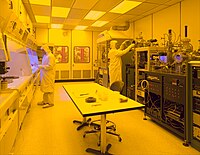
Photo from wikipedia
Little is known about how the chemical properties (molecular structure, such as the hydrophobic and hydrophilic end group for organic chemical, and particle size for nanomaterials (NMs)) quantitatively affect the… Click to show full abstract
Little is known about how the chemical properties (molecular structure, such as the hydrophobic and hydrophilic end group for organic chemical, and particle size for nanomaterials (NMs)) quantitatively affect the toxicokinetics (TK) in organisms especially in short-term, single-species studies. A novel method based on a first-order one compartment TK model which described the monophasic uptake pattern and two-compartment TK model which adequately described the biphasic metabolism pattern was used to determine the bioconcentration and TK rate constants of organic compounds (n = 17) and nanomaterials (NMs, n = 7) in zebrafish. For both one and two compartment model, the uptake (kin) and elimination (kout) rate constants were fitted using a one- and two-compartment first-order kinetic model, and bioconcentration factors (BCF) and 95% depuration times (t95) for all tested chemicals were calculated, respectively. The results showed that there was significant difference in TK parameters kin, kout, and BCF between organic chemicals and nano metal oxides. For organic compounds, significant correlations were found between the kin and BCF and the octanol-water partition coefficient (Kow) and molecular mass. For nano metal oxides, there was a significant negative correlation between the kin or BCF and particle size, but a positive correlation between kin and Zeta potential of nanoparticles and also a significant positive correlation between kout and particle size or specific surface area. Those findings indicated that NMs particle size does matter in biological influx and efflux processes. Our results suggest that the TK process for organic compound and NMs are correlated by different chemical properties and highlight that the Kow, the absorption kin, metabolism k12 and k21, elimination rate kout, and all the parameters that enable the prediction and partitioning of chemicals need to be precisely determined in order to allow an effective TK modeling. It would therefore appear that the TK process of untested chemicals by a fish may be extrapolated from known chemical properties.
Journal Title: Ecotoxicology and environmental safety
Year Published: 2019
Link to full text (if available)
Share on Social Media: Sign Up to like & get
recommendations!